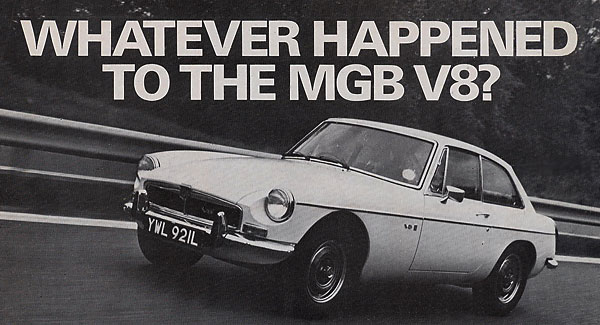
The cumbersome MGC was a flop but the MGB V8 couldn't fail with its lightweight
Rover engine. So why were so few made? Why is it not made now? Chris Harvey
looks at the fate of MG's cut-price supercar that is now valued as an appreciating
asset as well as an appealing road burner.
as published in British V8 Newsletter, Volume XV Issue 3, December 2007
Re-printed unedited by exclusive written permission of "Classic and Sportscar".
(This article originally appeared in the June 1979 issue of "Old Motor" magazine.
Sometime between 1979 and 1983, Old Motor magazine was re-launched as Classic and Sportscar.)
You know what they say about MGs: they are the most popular, loveable sports cars in the world, but they don't go fast enough. You can just about top the ton in the current antique, the MGB, if you live on the right side of the pond; if you are unfortunate enough to be an American enthusiast, you'll be lucky to squeeze 90 out of your emission-strangled B. Why are they so popular, then? Because they are the last rip-roaring hair-in-the-air, well-nigh indestructible sports car in full-scale production. The B might ride like the rocky road to Dublin but it will cling on when most of the rest have slid into oblivion. All it needs is a bit of oomph, so it is amazing that Abingdon's attempts at producing a really quick car have met with commercial disaster. Both the MGC (MGB plus two cylinders) and the MGB GT V8 (MGB plus four) were good for more than 120mph, but the C handled like a barge because the engine was too heavy and the V8 was killed by politics and the totally false impression that it gobbled fuel in the height of an energy crisis. In fact they made only 2591 V8s; with the exception of the Boy's Own Paper hot rod, the MGA Twin Cam (of which 2111 were built) it was the smallest production run from Abingdon since the war. As the V8 was also the fastest production MG, and one of the best handling, it immediately became a collector's piece as soon as they stopped making them in July 1976. Seems like we never know how good a car is until it's gone.
You'll have to pay up to £4000 for a really good new one now, the price of a new
MGB and double that of the equivalent four-cylinder made at the same time. Nearly half
(1072) of the V8s made had a chrome front - a body that looked exactly like that of the
equivalent MGB GT; the rest were the rubber bumper model made from October 1974 to meet
short-sighted U.S. Federal safety regulations. These later V8's also suffered from a spot
of penny-pinching in that British Leyland omitted to fit anti-roll bars front and rear to
make up for the deterioration in handling brought about by raising the ride height to help
meet the new bumper regulations. Actually, all the production MGB V8s had a slightly higher
ride height because they had fatter 175-section tyre and alloy road wheels against the
four-cylinder's 165 x 14 wires or steel wheels. Apart from a modest sprinkling of V8
badges, their wheels, and slightly higher ride height - giving a more muscular appearance
- were the chief way of telling them apart from the four-cylinder cars, apart from driving
them, of course.
The difference in performance imparted by the V8's all-alloy 3528cc Rover engine was
fantastic. It was good for 124mph, with a 0-60mph time of 8.6sec and standing quarter mile
in 16.4sec against the four-cylinder car's 102mph, 13sec and 18.5 (reduced to 96mph, 14.6
and 20.2 in 1973 Federal specification). Fuel consumption was very good: 25mpg against 27mpg
from the four-cylinder. People just assumed that an MGB with a V8 engine was thirstier than
the lower-powered car and British Leyland did little to quell their fears apart from coughing
up a generous quota of road test cars for the popular magazines of the day and leaving people
to find out for themselves. An advertising campaign emphasizing this point would have done
the world of good for V8 sales, but, then, it was never a popular model in corporate circles.
|
Enjoying this article? Our magazine is funded through the generous support of sponsors like: Mantell Motorsport "Where the Spirit of Driving has a Home!" (Pete Mantell specializes in Ford-based MGB-V8 conversions/parts and powder coating.) |
British Leyland only authorized production in what seems a fit of pique. Down at Abingdon they had been fiddling about with MGB V8s for years. Designer Syd Enever tried all sorts of combinations, including Coventry Climax and Daimler engines when Jaguar joined the fold in 1968. It was obvious that his stiff MGB shell would take a more powerful engine provided it didn't weigh appreciably more than the existing B-series unit's 358lb. The MGC of 1967 had used a modified MGB shell and proved to be a disaster when BMC's redesigned C series 2912cc engine tipped the scales at no less than 567lb. "It should have been half a hundredweight lighter," said John Thornley, the man in charge of MGs at the time. Rover's magnificent alloy V8 weighed about 320lb. (and slightly more than the B series engine when equipped with beefed-up ancillaries), but did not come into the reckoning for a variety reasons in 1967: Rover needed all the engines they could produce and fitting it to an MGB would have increased the demand considerably. Beside MG and Rover were not yet in the same commercial group, British Leyland.
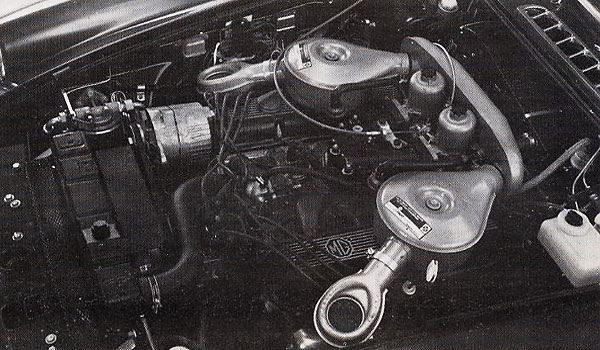
Rover's ex-Buick light-alloy V8 shoehorned neatly into the MGB's engine bay:
It weighed 250lb less than the straight-six C and gave more power.
The history of Rover's wonderfully versatile engine is fascinating. This pushrod unit
had been developed from a General Motors engine used between 1960 and 1963. The Americans
stopped production when their thin-wall iron casting techniques improved sufficiently to
make the lightweight V8 an oddball in their range. It was spotted accidentally by a Rover
executive and built under license for the company's saloons and later the Range Rover.
Fitting it to the MGB in 1967 would have involved considerable expenditure in meeting
anti-emission regulations and could have caused problems with General Motors who did not
want to see a cheap, and fast, MGB competing with their Stingray, and using one of their
engines.
(British V8 editor's note: Fitting a discontinued GM engine into MGC wasn't a realistic
option when the MGC was being developed. Remarkably, many people fail to note the obvious
American alternative: the small-block Ford V8 engine that was already being used in
British-made Sunbeam Tigers. The timing could have worked out so well: with purchase of
Sunbeam by Chrysler, Ford had reason to look for another customer. The Ford 289 V8 in
Mark-2 Tigers was 150lbs. lighter than an MGC six, yet it produced far more power and
torque. Ford had to comply with the same anti-emission regulations mentioned above, so
MG's engineering costs would have been largely mitigated. The MGC chassis provided a
stronger, stiffer platform than the Sunbeam Tiger, superior handling, and a GT bodyshell
option. MG's much larger dealer network, compared to Sunbeam, would have made an MGC with
factory-installed Ford V8 a great success.)
However, during 1970, when MGC production had been abandoned, a garage proprietor from
Kent, Ken Costello, who had raced MGBs, started experimenting with fitting the Rover V8
engine to the cars of customers who wanted more performance without the handling problems
of the MGC. It was an extraordinarily attractive unit, producing 185bhp at 5000rpm in the
10.5:1 compression ratio form used in Rover saloons and 137bhp in the 8.25:1 Range Rover
form. The torque, 226 lb. ft. was massive and proved to be something of an Achilles heel
to the Costello V8s when mated with the standard MGB all-synchromesh gearbox it was rather
too much. However, other advantages of the installation tended to blind people to this
problem; a variety of stiffer rear springs were available to provide tramp-free take-off
and the performance was phenomenal - 130mph, 0-60mph in 7.8sec. and the standing quarter
mile in 15.8sec with the heavier GT version. This weighed 20.5cwt with a fiberglass bonnet
reshaped to clear the Rover engine's twin SU carburetters. Roadsters weighed around 1cwt
less and were slightly faster.
There was one additional problem with the roadster in that its shell was not really stiff
enough to take all that torque. These bespoke Costello cars retailed at around £2600
in 1972 with the larger (9.5 in.) MGC clutch and higher rear axle ratio (3.07 against 3.9:1);
more than double the price of a standard MGB GT at the time. Nevertheless, they received
considerable publicity and demand was quite high. After the debacles of the MGC, British
Leyland were stung into action. They stopped supplying new engines to Ken Costello and
started work on their own MGB V8. Costello soldiered on with exchange units and the odd
errant Buick, but there was no hope of him setting up a production line.
Enjoying this article? Our magazine is funded through the generous support of readers like you!
To contribute to our operating budget, please click here and follow the instructions.
(Suggested contribution is twenty bucks per year. Feel free to give more!)
Meanwhile Abingdon ran up their first MGB with Rover power in December 1972; it was an
extraordinarily neat conversion of the GT shell using the Range Rover version of the V8
and SU carburetters as they considered that its 137bhp and 193lb. ft. of torque were
quite sufficient for the gearbox and rear springs, which were stiffened in any case.
A special inlet manifold was used so that the carburetters could be squeezed under a
standard bonnet (British Leyland had come in for considerable criticism from America
for the bulges on the MGC bonnet) and a higher ratio overdrive gearbox with 3.07:1 rear
axle. Fuel consumption was thus improved to around 25 mpg against Costello's lower-geared
cars, which returned about 18mpg.
Some slight modifications were needed to the cars' shells (mostly rounding off corners
in the engine compartment) and it was decided to standardize this with the four-cylinder
machine. Thus, all the MGBs from mid-1973 when V8 production got under way were built
with this new shell. Only the GT version was built by the factory, however, who were
worried about the roadster's rigidity. It was intended to export the MG V8 to America
(where the vast majority of MGBs were sent) and seven left-hand-drive cars were built
in the development department at Abingdon alongside ten right-hand-drive ones in
January and February 1973. However, the same situation that had gone against the MG V8
in 1967 still applied and there was the problem that there was hardly sufficient room
under the bonnet for America's increasingly bulky emission equipment. Eventually, the
MGB GT V8 was announced in right-hand-drive form only in August 1973. Two of the
left-hand-drive cars were sent to the New York Motor Show and were returned to Abingdon
later to join the other five, which were retained until 1974 and 1975. Six were then
sold to European customers and the other went to British rallyman Michael Pearson, who
campaigned it with considerable success. Swiss MG enthusiast Thomas Studer bought one
of the other left-hand-drive cars and races that on the track.
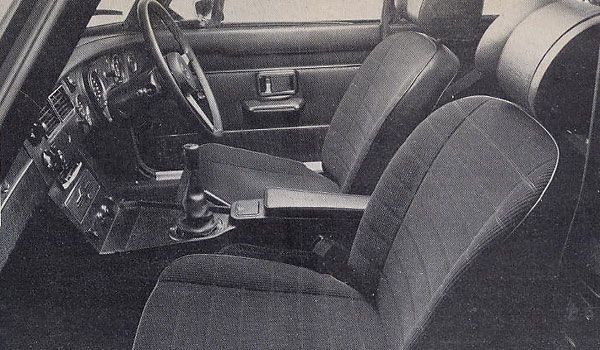
Interior of the first '73 MGB V8 - simple to the point of being austere,
but comfortable and cosy with it. Seat had plaid cloth upholstery.
Unfortunately, just as the MGB GT V8 was launched, Britain was about to lurch into a
deepening energy crisis and this, with the difficulties in building enough V8 engines,
kept production down. The price didn't help either: £2294 in the United Kingdom
against £1547 for a four-cylinder MGB and only £1824 for the nearest
competitor, the Ford Capri 3000 GXL. The V8 could have been offered for £1800-1900,
but British Leyland figured that Costello's had sold for much more and there
was a market for a limited amount at the higher price. This was not to prove the case,
however, and production petered out (1069 cars built in 1973, 854 in 1974, 489 in 1975
and only 176 in 1976) before the V8 was no more. One more factor that went against it
was that British Leyland decided to drop the MGB GT in America in 1975 to give their
new hope, the Triumph TR7, a clear run.
As with any MGB, you have to check for rust in the sills and wings of an elderly example
(this can be quite easily prevented by modern rust-proofing agents); with the V8s be
especially wary of a noisy gearbox (even in its 137bhp standard form, the box was on
the limit of its capacity), and anything other than a very smooth engine. The switches
on the V8's twin electric fans are notoriously unreliable and can lead to unexpected
overheating with subsequent engine trouble.
Such is the interest in the renaissance of the MGB V8 that rumour has it that British
Leyland are about to make more. This has been hotly denied by official sources, who
make the point that the four-cylinder cars are still selling so well (and pass the
half-million production figure this year) that they have their work cut out producing
enough of them!
Chatham's open V8
After the demise of the production cars, there was still a certain demand for the MG
V8, and Costello continued to convert the odd car. Another garage proprietor and
racing driver, John Chatham wondered what he could do to alleviate the situation.
What the enthusiasts really wanted, he reasoned, was an open MG with V8 performance.
With the considerable experience of running and building Big Healeys and ex-works
MGCs behind him, Chatham decided to use the MGC shell for his prototype. This was
much stiffer than that of the MGB roadster and he had lots of ex-works parts in any
case. He then obtained a modified V8 engine giving around 200bhp fitted with a
Costello Weber conversion, and mated it to an MGC gearbox. To get over the MGB V8's
gearbox problem, he fitted works straight-cut gear clusters and competition overdrive
on third and fourth with a 3.7:1 limited slip rear axle, 14in. x 7in. Minilite wheels
and low-profile tyres. Suspension and braking were uprated to competition standards
and the performance was shattering.
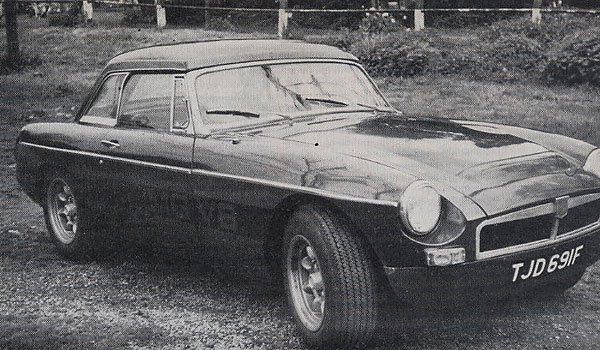
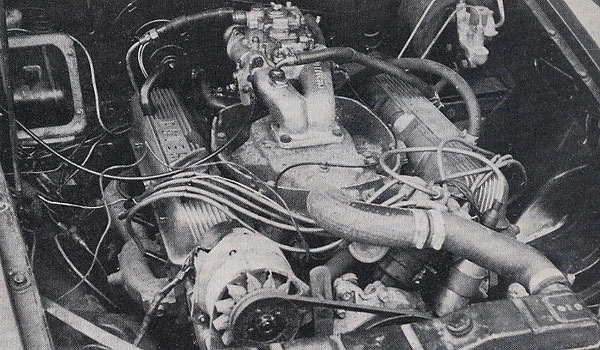
Chris Harvey's Chatham-converted V8-engined MGC roadster on Minilite wheels and 7in.
tyres. With modified 200bhp engine, the car will sprint to 60mph in under 6 seconds.
When I first tried the car soon after it was completed in Bristol in February 1978
it recorded a tyre-smoking 5.8sec 0-60mph time with an unmentionable top speed! Like
all MG V8s, its 50/50 weight distribution gave it dream-like handling and it took no
sales talk from Chatham for me to buy the car. In 35,000 miles since then it still
retains the V8's turbine-like power and has shown me why these machines are sought
so avidly be collectors.
You can still buy a new MGB GT V8. After converting a number of second hand cars for
customers, Chatham built his first all-new V8 in January. Using a Rover SD1 engine
and five-speed gearbox with Triumph TR7 C8 Offenhauser manifold and Holley four-choke
carburetter, plus Minilite wheels, this machine cost £8200, less the value of
the new four-cylinder engine, gearbox, wheels and tyres removed.
BritishV8 Magazine has assembled the largest, most authoritative collection of MG "MGB GT V8" information you'll find anywhere. Check it out! Access our MGB GT V8 article index by clicking here.

